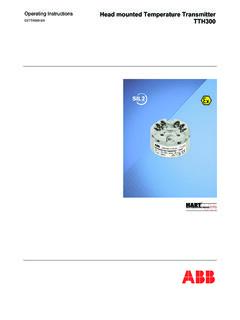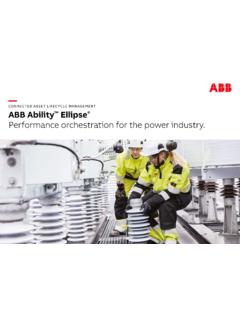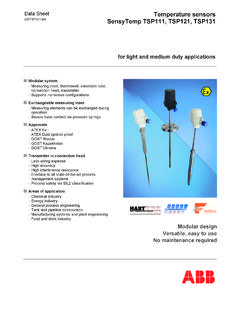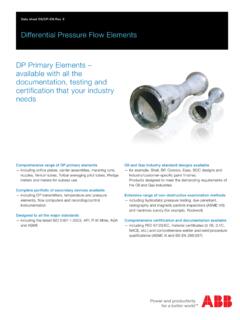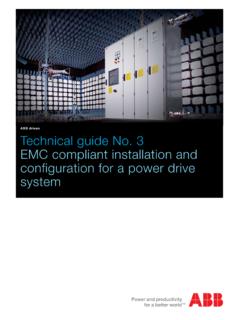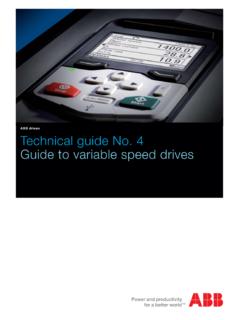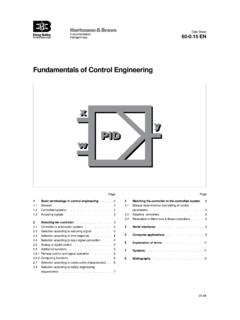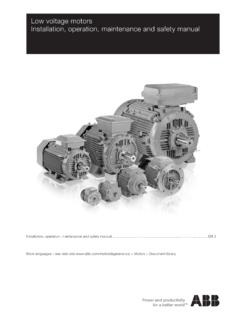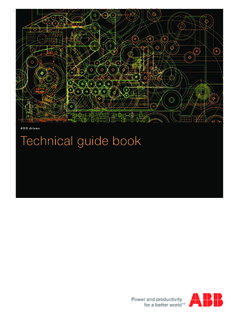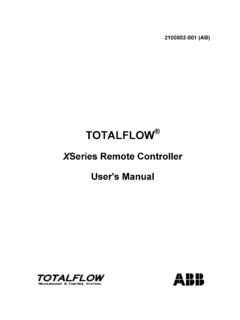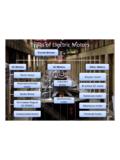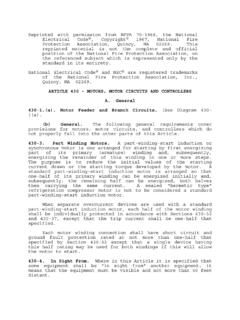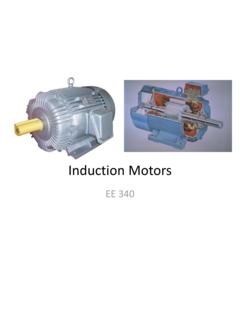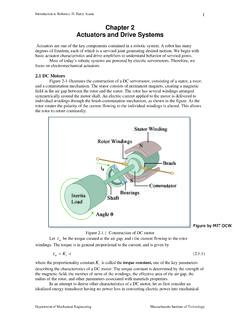Transcription of Handbook Softstarter Handbook - ABB
1 Handbook Softstarter Handbook The purpose of this Handbook is to provide guidance for correct selection and maintenance of softstarters in industrial installations to ensure a trouble free operation. This without increasing the overall cost. Softstarter Handbook | 1 SFC132060M0201. FOREWORD. This book is written with the thought of being a general guide for people working with Softstarter applications but also for those just interested in learning more about this type of starting method. It doesn't matter if you are an expert or novice, hopefully you will find some interesting and useful information either by reading from cover to cover or just the chapters of interest. The index at the end of the book can be used to simplify your search. The contents of this book is very much based on the 25 years of experience we have within ABB of developing, manufacturing and selling low voltage softstarters . The book is not a complete technical guide or manual for all types of ABB.
2 softstarters that may exist on the market. It is a complement to the technical catalogues and brochures we have for our products and will give a general picture of what to think about when working with softstarters . More information about softstarters as well as other ABB products is available on All advice given in this book is only general and every single application must be handled as a specific case. ABB AB, Cewe-Control November 2010. Johan Rees Magnus Kjellberg S ren Kling Softstarter Handbook 1 SFC132060M0201 | I. ABB will not take any responsibility for any type of faults or damage due to the use of this Handbook . II | Softstarter Handbook 1 SFC132060M0201. Contents Standards and approvals .. 1. Definitions, different voltages .. 3. About motors .. 4. Squirrel cage motors .. 5. Speed .. 6. Voltage .. 7. Current .. 8. Power factor .. 8. Torque .. 9. Slipring motors .. 9. Different load conditions .. 10.
3 Different starting methods .. 12. Direct on line (DOL) .. 13. Star-delta starter .. 14. Frequency converter .. 16. Softstarter .. 18. Comparision between different starting methods .. 20. General about softstarters .. 21. Softstarter functionality .. 22. Torque control .. 24. Different applications .. 26. Centrifugal fan .. 27. Centrifugal pump .. 29. Compressor .. 32. Conveyor belt .. 34. Crusher and Mill .. 37. Softstarter Softstarter Handbook 1 SFC132060M0201 ||IIIII. Handbook 1 SFC132060M0201. Contents How to select a Softstarter for different applications .. 39. Ambient temperature .. 40. Derating when used at high altitudes .. 41. Starting capacity and overload protection .. 42. Number of starts per hour .. 44. Prosoft .. 45. Different ways of connecting the Softstarter .. 46. Start of several motors .. 48. Connection of control circuit .. 50. Connecting a Softstarter to a fieldbus system .. 51. 2-phase control vs 3-phase control.
4 52. Settings .. 54. Explosive atmospheres .. 58. Coordination .. 60. Environmental information .. 67. Harmonics .. 68. FAQ (Frequently asked questions) .. 69. Quantities and units .. 71. Formulas and conversion factors .. 72. Glossary .. 76. Index .. 83. IV | Softstarter Handbook 1 SFC132060M0201. Standards and approvals All ABB low voltage softstarters are developed and manufactured according to the rules set out in the IEC (International Electrotechnical Commission). The IEC issue publications that act as a basis for the world market. The IEC. standard for softstarters is called IEC 60947-4-2 and softstarters built according to this standard are in most countries not subject to any other tests besides the manufacturer responsibility. In some countries, law requires certificates. European Directives CE Marking There are three essential European direc- When a product is verified according to tives: its applicable EN standard, the product is presumed to fulfil both the Low Voltage Low Voltage Directive 206/95/EC.
5 Directive and Electromagnetic Compa- Concerns electrical equipment from 50 to bility Directive and it is allowed to use the 1000 V AC and from 75 to 1500 V DC. CE marking on the product. EN 60947-4- Machines Directive 2006/42/EC 2 is the harmonized standard for softstart- Concerns safety specifications of ma- ers and it is identical to IEC 60947-4-2. chines and equipment on complete ma- In this case, the CE marking does not chines. cover the Machines Directive which will Electromagnetic Compatibility Directive require a special verification of the instal- 2004/108/EC lation of the machine. Since a Softstarter is Concerns all devices able to create elec- an electrical device, with mainly electrical tro-magnetic disturbance including the risks, it is instead covered by the low volt- level of emission and immunity. age directive. The CE marking is not a quality label; it is proof of conformity with the European Directives concerning the product.
6 Softstarter Handbook 1 SFC132060M0201 | 1. Standards Specifications in USA and Canada Other local approvals based on The specifications for the American and IEC-standard Canadian markets are quite similar, but In addition to IEC and UL standards, many differ a lot from the IEC standards and Eu- countries have their own local standards. ropean specifications. Some of the major ones besides the already mentioned CSA and CCC are listed below: USA - UL Underwriters Laboratories Inc. GOST Russia Canada - CSA Canadian Standards As- C-tick Australia sociation ANCE Mexico There are different types of UL certifica- Marine approvals tion, among them UL listed and UL com- For softstarters used on board ships, mari- ponent recognition. UL listing means that time insurance companies sometime require UL has tested representative samples of different marine certificates of approvals. the product and determined that it meets These can come from BV (Bureau Veritas), UL's requirements.
7 UL's component rec- GL (Germanisher Lloyd), LR (Lloyd's Reg- ognition service, however, only covers the ister EMEA) which are based on the IEC. evaluation of components or materials in- standard, or from ABS (American Bureau of tended for use in a complete product or Shipping) which is based on the UL stan- system. All ABB softstarters that have UL dard or from some other independent cer- certification, are UL listed. tification organisation. Normally, marine ap- provals have special requirements regarding softstarters can also be cULus listed, shock, vibrations and humidity. meaning that they are UL listed to US and Canadian safety standards. All the require- Used standards ments of both UL and CSA are covered by Following standards are used or partly used cULus, so the product is then suitable for for the softstarters . use in the US and in Canada. IEC 60947-1. EN 60947-1. CCC (China Compulsory Certification).
8 IEC 60947-4-2. Since the Softstarter standard is listed ac- EN 60947-4-2. cording to the CCC-regulation in China, UL 508. it is mandatory to have the product ap- CSA No. 14. proved and labelled with a CCC-mark to be allowed to be put on the Chinese mar- LR Test specification No. 1. ket. The Chinese stan- dard is based on the IEC-standard IEC. 60947-4-2. 2 | Softstarter Handbook 1 SFC132060M0201. Definitions, different voltages Different named voltages are used for the softstarters . The name and use of these different voltages is stated in the IEC-standard (IEC 60947-1) as below. Operational voltage (Ue), Control circuit voltage (Uc), is the voltage feeding the motor and also is the voltage for controlling the start the voltage exposed to the main circuit and stop command of the Softstarter . (thyristors) in the Softstarter . 200 - 690 V AC Common values are 24 V DC or 110 - 240. are normal values. V AC. On many softstarters , the control voltage can be supplied internally.
9 Control supply voltage (Us), is the voltage feeding the electronic com- ponents inside the Softstarter , for example the printed circuit board. A common volt- age is 100 - 250 V AC. Softstarter with internal control circuit voltage Softstarter with external control circuit voltage Softstarter Handbook 1 SFC132060M0201 | 3. 2. About Motors Modern electrical motors are available in many different forms, such as single phase motors, three-phase motors, brake motors, synchronous motors, asyn- chronous motors, special customised motors, two speed motors, three speed motors, and so on, all with their own performance and characteristics. For each type of motor there are many different mounting arrangements, for ex- ample foot mounting, flange mounting or combined foot and flange mounting. The cooling method can also differ very much, from the simplest motor with free self-circulation of air to a more complex motor with totally enclosed air-water cooling with an interchangeable cassette type of cooler.
10 To ensure a long life for the motor it is important to select it with the correct degree of protection when operating under heavy-duty conditions in a severe environment. The two letters IP (International Protection) state the degree of protection followed by two digits, the first of which indicates the degree of protection against contact and pen- etration of solid objects, whereas the second states the motor's degree of protection against water. The end of the motor is defined in the IEC-standard as follows: The D-end is normally the drive end of the motor. The N-end is normally the non-drive end of the motor. Note that in this Handbook we will focus on asynchronous 3-phase electrical motors only. Terminal box Cooling fan Drive shaft D-end N-end Stator Stator windings Rotor 4 | Softstarter Handbook 1 SFC132060M0201. Squirrel cage motors In this book the focus has been placed on the squirrel cage motor, the most common type of motor on the market.
